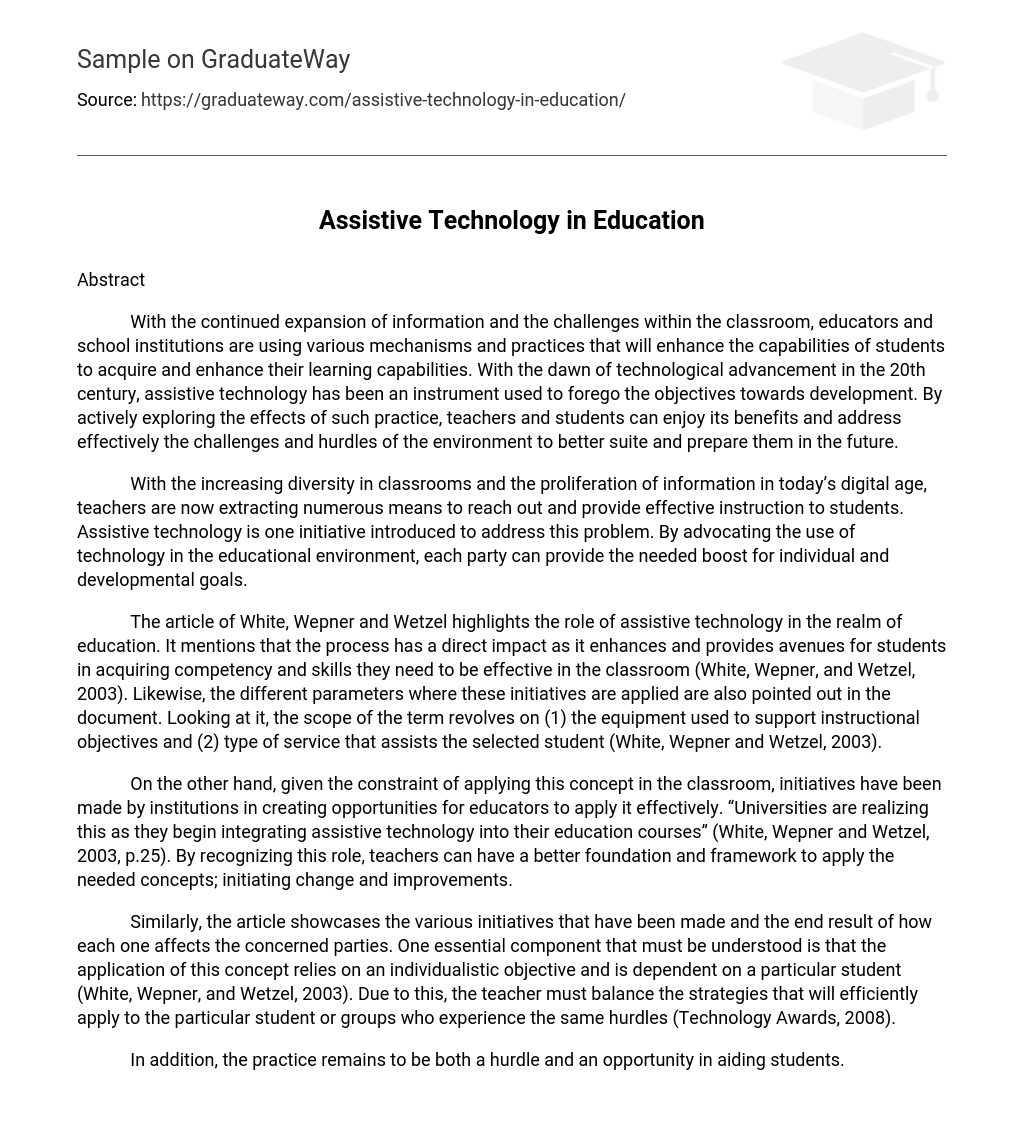Abstract
With the continued expansion of information and the challenges within the classroom, educators and school institutions are using various mechanisms and practices that will enhance the capabilities of students to acquire and enhance their learning capabilities. With the dawn of technological advancement in the 20th century, assistive technology has been an instrument used to forego the objectives towards development. By actively exploring the effects of such practice, teachers and students can enjoy its benefits and address effectively the challenges and hurdles of the environment to better suite and prepare them in the future.
With the increasing diversity in classrooms and the proliferation of information in today’s digital age, teachers are now extracting numerous means to reach out and provide effective instruction to students. Assistive technology is one initiative introduced to address this problem. By advocating the use of technology in the educational environment, each party can provide the needed boost for individual and developmental goals.
The article of White, Wepner and Wetzel highlights the role of assistive technology in the realm of education. It mentions that the process has a direct impact as it enhances and provides avenues for students in acquiring competency and skills they need to be effective in the classroom (White, Wepner, and Wetzel, 2003). Likewise, the different parameters where these initiatives are applied are also pointed out in the document. Looking at it, the scope of the term revolves on (1) the equipment used to support instructional objectives and (2) type of service that assists the selected student (White, Wepner and Wetzel, 2003).
On the other hand, given the constraint of applying this concept in the classroom, initiatives have been made by institutions in creating opportunities for educators to apply it effectively. “Universities are realizing this as they begin integrating assistive technology into their education courses” (White, Wepner and Wetzel, 2003, p.25). By recognizing this role, teachers can have a better foundation and framework to apply the needed concepts; initiating change and improvements.
Similarly, the article showcases the various initiatives that have been made and the end result of how each one affects the concerned parties. One essential component that must be understood is that the application of this concept relies on an individualistic objective and is dependent on a particular student (White, Wepner, and Wetzel, 2003). Due to this, the teacher must balance the strategies that will efficiently apply to the particular student or groups who experience the same hurdles (Technology Awards, 2008).
In addition, the practice remains to be both a hurdle and an opportunity in aiding students. The subjectivity of application remains to be the utmost hurdle because of its capability to cater to a selected few who are trailing or left behind. Moreover, the new devices introduced again provides hurdle for teachers as they try to familiarize themselves in the process. But it is also an opportunity because “it helps in the development of teaching-learning material in accordance with the desired objectives, designed curriculum and available resources” (Bright Hub, 2008, p.1).
Lastly, assistive technology is seen as a scheme to overcome barriers brought about by inclusion and disabilities. With the initiative brought about by the No Child Left behind Policy (NCLB), there is an increased accountability and standards in providing the necessary learning environment for students (Martin, 2006). Given stable and effective funding programs, it can lead to continued advancement of training necessary for sustenance in meeting the objectives and goals not only for teachers but also for students who need the required attention.
To conclude, the practice of assistive technology is an important instrument in enhancing the capabilities of students to adapt to the changes happening in education. It provides a positive impact in student achievement and creating sustained competence and acquisition of skills. Though there are continuing limitations for its application, the collaboration among educators, the government and parents can lead to its further expansion. With the increasing challenges and hurdles brought about by diversification and inclusion within the classroom, teachers must constantly equip themselves with further education and training to supplement their experiences in constructing an avenue for growth and holistic achievement.
References
Bright Hub (2008) Role of education technology in improving education. Retrieved October 20,
2008 from, http://www.brighthub.com/education/special/articles/11620.aspx
Martin, S.S. (2006) Special Education, Technology, and Teacher Education. [online] Retrieved
October 20, 2008 from, http://site.aace.org/pubs/foresite/SpecialEducation.PDF 1-8.
Technology Awards (2008) Assistive Technology in Education. Retrieved October 20, 2008
from, http://www.technologyawards.org/assistive_technology/Assistive_Technology_and_Special_Education.html
White, A.W., Wepner, S.B. and Wetzel, D.C. (February 2003) Accessible Education Through
Assistive Technology in T.H.E. Journal. 30 no. 7 Retrieved October 20, 2008. 24-32.





